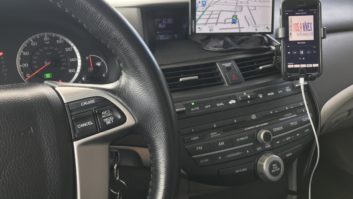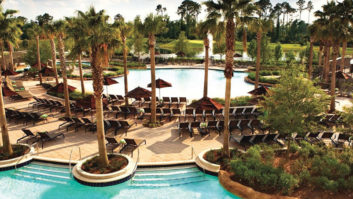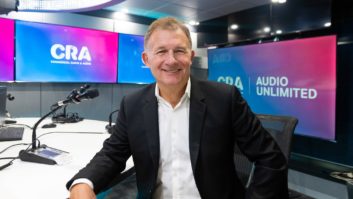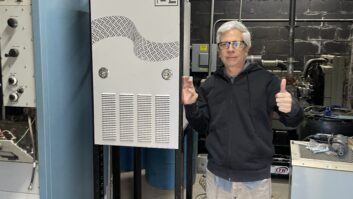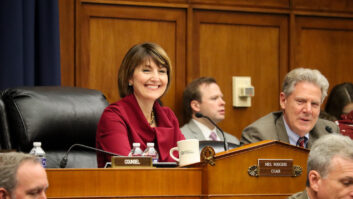
Julius Marchwicki
Credit: © Ford Motor Company
Julius Marchwicki is all about the apps.
As global product manager for Ford Sync AppLink, he’s at the center of what automakers are doing to entice young people into buying cars. Bigger engines don’t do the trick anymore, according to experts in that world; so Marchwicki works with companies like Pandora, Stitcher and Clear Channel to deliver in-vehicle connectivity to infotainment sources.
Sync is the automaker’s connectivity system, AppLink is an application programming interface. Marchwicki works with companies in application development and content creation and distribution, wireless handset and platform development, to deliver features into cars that consumers want.
The Northwestern University computer engineering grad spoke with Radio World News Editor/Washington Bureau Chief Leslie Stimson about how “radio” in all of its forms fits into the new dashboard, part of a new series of articles on radio’s role in the evolving world of consumer electronics.
RW: When you think of radio, what comes to mind?
Marchwicki: When I think of radio, I think of an easy way to access localized content for any reason anywhere in the world. That content can be anything. It’s music, it’s news, it’s all sorts of things.
There’s obviously a ton of content that’s delivered through radio. Traditionally, radio’s only been [in one] area… When you leave that area … you lose the radio stations that you’re familiar with at home and you suddenly have different radio stations, different personalities. Obviously, between areas, you lose signal and you have to find something new.
Today, the age of the Internet and mobile phones as data connectivity has brought us to a world where I can access any radio station anywhere in the world anytime; and I personally think that’s fantastic. … Now we’re entering a world of applications and a world of data connectivity everywhere.
RW: Radio in the car is changing so much with connectivity with the phone.Jacobs Media is now Ford’s development house and I’m wondering, AM/FM traditional radio is trying to stay relevant in the dash. They want to be on that first screen that comes up. What should stations be doing?
Marchwicki: My thinking is they need to start categorizing their content and making the unique aspects of their programming available to anyone at anytime.
One of the good things that Greater Media has done with its properties, they’ve started to record the morning shows and make them available. Basically you’re caching content … so you miss the morning show, but you wanted to hear it later in the day or later that week. Morning shows are great but sometimes you miss a segment. How do you get that segment?
RW: You can podcast…
Marchwicki: You can podcast it or you can get it from the application inside the car. Or, for example, you say “I’m going to time-shift. I missed this. Maybe I can start at the beginning and listen to it.” And I can get back in the car later and I can listen to the rest of the morning show on my way home. … You can access that type of content through many applications. But the way you access that is you start to categorize that. You start to take the unique aspects of your station, your programming, and make that available outside of the time in which it was broadcast.

Ford drivers with Sync AppLink now listen to and control Greater Media radio stations on their smartphone using voice commands. Stations include Detroit’s WRIF(FM) and WCSX(FM), on 101.1 and 94.7 MHz respectively.
Credit: © Ford Motor Company
RW: Making it available through an app?
Marchwicki: Applications are definitely very common; it’s a good way to go. Companies like Jacobs Media can help get you that content into an application. So there’s that. There’s also making it available on the Web. However I think there’s a piece that’s missing. You need to connect your listenership with that experience. What we’ve seen with Clear Channel, for example — they’ve taken their programming and they’ve created a method by which you can access all their content at any time.
RW: You’re talking about iHeartRadio…
Marchwicki: I’m talking about iHeartRadio, an incredibly powerful, fascinating product. What a smaller radio station may want to do, for example, they can work with someone like a Jacobs Media or anther apps development house. So they have this application, and they can get their content and start to store and publish their content outside the context of their programming. But that missing step is they need to connect their listenership that is listening on the radio, they need to connect them to that application. They need to incentivize use of that application, and they need to present, potentially, new content, whatever that may be. … You need to give them a reason to go digital. And then you need to start presenting them a unique experience so you’re prepped for a world where terrestrial radio — and I don’t expect it to go anywhere anytime soon — we’re going to start to see user trends change away from terrestrial to a more broadened device strategy through a connected strategy. That’s the way I see the industry changing.
RW: So we can expect to see music tastes changing away from traditional media or…
Marchwicki: No, it’s more about how users are listening. The other thing I’d add is, a lot of what I’m saying concerns music content, but [it ’s] the same with news. There are stations in certain markets that still do some of their own news, they have someone that reads the news, that’s something that can be provided to their customers through this digital experience.
RW: How does ford view HD Radio? Sync was one of the first infotainment systems to include HD.
Marchwicki: We have HD Radio. It’s a fantastic product. There are some advantages. You have higher quality, additional metadata and they continue to innovate in this space. There’s higher bandwidth and you have more content on some of the sideband channels that you have on particular frequencies. We have it in many of our vehicles. It’s a product that some of our customers are asking us for. It’s definitely something we’re going to continue to have in our vehicles.
RW: What about satellite radio. Are you still going to include that in your product?
Marchwicki: SiriusXM [has] a lot of compelling content that is available everywhere in the States. You don’t have the same problems that a traditional AM/FM station does, which is you drove out of range. Users are asking for it. They’re demanding it. For the foreseeable future I don’t see us moving away from satellite in any way.
We’re just trying to give consumers options, more choice. Some customers may not want satellite radio but they prefer Pandora, so [we] provide whatever it is that they want to listen to, we provide that experience to them.
RW: You’re trying to give them everything they’re asking for.
Marchwicki: That’s the goal of the developer program, which allows us to bring greater content from all over the world. That’s what’s important. Because we’re talking about North America, but there are plenty of radio stations in Europe and Asia where we sell a significant amount of vehicles. They are just starting to get into these trends as well where you have these digital experiences on devices.
That’s part of why we did the developer program. I don’t know what radio station is popular in Germany. But a developer in Germany knows. They’ve probably already created the application that does … radio, so if I bring vehicles to Germany that have AppLink, there are applications that support that experience inside the car.
RW: For a more high-level question; why is Ford employing apps as opposed to building a different radio?
Marchwicki: One of the reasons why is we want to be able to, as a car company, keep up with changing trends in technology [is] because it takes us so long to design and engineer a radio, and then build it into a car. By the time the radio in a car is built, it’s almost a year and a half old. With this technology, with Ford Sync AppLink, we can stay relevant.
Say there’s a new radio station or new content that’s coming. How do you plan for that? HD Radio has all this fantastic content but you can’t get it unless you have an HD tuner. But the data can come to you through your phone. And the phone can present that to you like it’s integrated. It can look like it’s part of the experience and I never have to change the car again. … I didn’t have to add a tuner.

Ford enabled the NPR news app to be voice-activated through the Sync AppLink last year.
Credit: © Ford Motor Company
RW: Are AM and FM always going to be in the dash?
Marchwicki: Probably. I think there’s something very visceral about turning a car on and having audio come out — not needing and requiring a data connection. Me personally, there could be some very, very low-cost vehicles that only have some speakers and don’t have a tuner, for example. They use everything through a mobile device. That’s possible, but I don’t see that happening for a long, long time.
RW: How does the Jacobs Media deal work?
Marchwicki: If you’re a radio station and you’re looking for an application to be developed, Jacobs Media or JacApps … are in the business of getting your content and helping you take that content and go digital and get it onto their application platform. They can create a branded experience for you on Android and iOS devices.
RW: What’s Ford’s part in that?
Marchwicki: Our part is we’ve worked with Jacobs Media. They understand how our [software applications] work. So now when you come to Jacobs Media and you want to leverage their services, they have the ability to also add the AppLink capability to your applications. … Not only do you get an application, but you also have that application enabled in our vehicles so that it works with voice and some other items as well.
RW: It was interesting when you were talking about Germany, for example, and that AppLink works for a Ford that can be sold in any country. So a local station in a country could have their particular app, and the driver could customize the stream?
Marchwicki: The driver customizes their experience by customizing their phone, which they already do today. Our technology works based on the smartphone. If you want a particular radio station or stations, you download that app to your phone, and that application is available inside of your vehicle.
RW: Do you physically connect your phone to the dash with a cord, but you’re controlling your screen either by voice command or some other way?
Marchwicki: The phone. On an Android phone it connects wirelessly, and on an iPhone you connect with a USB cable. But once you’ve done that you just put your phone away. And then you can control the app with voice or steering wheel controls or buttons inside of the car.
RW: Is there anything else we should know about how Ford views radio in general?
Marchwicki: It’s definitely a big experience and we’re probably, more than any other automaker, trying to bring as many applications, trying to give the consumer as much choice as possible when it comes to their music listening. It’s not just about iHeartRadio. If you’re a WCSX or WRIF listener [in Detroit] those are fantastic music properties that are now available inter-vehicle, voice-activated. Jacobs Media’s helped us accomplish that goal significantly. We’re here to help everybody. That’s what the developer program’s all about.
RW: So down the road there could be other companies developing the radio apps…
Marchwicki: Absolutely, yes.
RW: And they would work with Ford directly?
Marchwicki: They would deal with the developer program, would be able to provide them with the necessary resources to create their products.
RW: Is the idea with AppLink, somehow the profits can be shared? Say If a station can send a coupon, or whatever…the ROI.
Marchwicki: Absolutely.
RW: But for the app program, does Ford get a slice of…
Marchwicki: It’s totally free.
RW: Say I’m listening to a Greater Media station and a coupon comes up on the display. I use the coupon for a purchase. Does Ford get a slice of that exchange?
Marchwicki: [Shakes his head no.] Our business is selling vehicles. We want a customer to buy a car because we offer them more choices, more innovation, more technology than anyone. That’s the way we look at it.
RW: When people come into showrooms today and look at the dash, what are they telling Ford they want to see?
Marchwicki: A lot of people ask us for Spotify [Ford and Spotify announced a deal to collaborate on an app, targeting the end of the first quarter for availability]. We give them an immense number of options for their entertainment. They pretty much have everything. Obviously there’s still some products we don’t have available to them. We are certainly moving forward in a way that consumers have the ultimate choice when it comes to using applications or getting the content that they want inside the vehicle seamlessly and safely as possible.
RW: Ford has a deal with Aha …
Marchwicki: They’re one of our developer partners.
RW: NPR and CBS Radio stations are on Aha.
Marchwicki: We launched NPR stations last year on AppLink. That’s a fantastic application, all voice-enabled. You can get all the content. It’s one of the great things about NPR. I was talking about categorizing your content. They do a fantastic job with that. They actually segment all their programs you can get three-minute segments or snippets of any NPR show ever.
RW: Engineers are talking to me about developing station icons, instead of text or just call letters showing up on the screen, because text or call letters on a display is boring compared to what you’d see on Pandora, for example. Is that something Ford helps out with at all?
Marchwicki: No, not really. That’s the business of the station itself. We’re not in the business of designing logos or changing the radio experience inside the vehicle. We’re there to provide a manner in which you can interact with your vehicle and access content. We have an HMI [Human-Machine Interface] and there’s room for album art. There are buttons and things that are pretty standard and straightforward. Those experiences translate pretty well across the board between vehicles. So it’s easy to find. But once you get into a Ford we want the experience to be one of: Here’s your vehicle and you are now able to access the content that’s on your phone.





